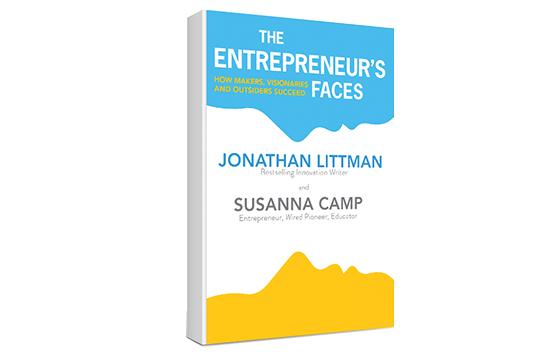Frontlist | The Entrepreneur’s Faces: Book Review
Frontlist | The Entrepreneur’s Faces: Book Reviewon Jan 12, 2021

If you like magazine profiles of start-up founders and entrepreneurs, this book is a veritable compendium, whatever you think of its somewhat contrived structure.
At any other time, the cover of The Entrepreneur's Faces might look like a chart of sales or growth; at the moment it looks more like an idyllic beachscape of sand and surf. But turn it sideways and the classic optical illusion transforms into two faces. Presumably they're two of the ten entrepreneurial archetypes -- the Faces -- profiled in the book, who will go through the seven stages of the Arc: The Awakening, The Shift, The Place, The Launch, The Money, The Test and The Scale. If these deliberately stylised steps sound familiar, that's because it's a version of the Hero's Journey, which is regularly used to structure books about start-ups. The authors describe each of the seven stages briefly, but they're mainly illustrated by following the careers of ten different people who represent what they see as the range of archetypes and mindsets into which entrepreneurs fit: The Maker, The Leader, The Athlete, The Accidental, The Visionary, The Guardian, The Conductor, The Evangelist, The Collaborator and The Outsider. These are actual founders, CEOs and leaders -- not all from the technology industry -- and there are more famous names listed for each archetype. Disappointingly, all but one of the Faces are men and it seems rather on the nose that the only woman represents a Guardian (Guardians protect and liberate people by taking down barriers or confronting inequities we're told). There isn't a quiz in the book to help readers self-identify as a specific Face (although there is one on the book's website that you can only access by giving a name and email address); you might find that one Face feels familiar, but as the authors point out at the very end, most successful entrepreneurs will need to adopt different roles -- something that may be more obvious in the workshops for which this book is a subtle advert. For each stage, we follow all ten of the Faces. Jumping from one Face to another means that you don't get bogged down in a particular narrative that might not speak to you, and you get to see multiple facets of each phase of experience. But the attempt to paint a vivid word picture of each entrepreneur resorts to so many clichés (eyeglasses making you look bookish, broad shoulders and classic athletic good looks, puckish smiles, 80s rock-star hair, a flaxen-haired pixie) that photographs or caricatures might have been helpful. And jumping between the Faces also means you can also lose track of what's happened to which person, either because the job or company that was going so well at the end of one section might be long gone when the next episode starts, or because there are just so many people to keep track of. Some of the Faces follow the familiar start-up story -- taking a product design class with the founder of IDEO and becoming so enamoured of reimagining snowshoes that they abandon any thought of a traditional career to build a snowshoe company, for example; or pursuing a law degree at Stanford but building a legal library search tool on the side. Others are inspired by friends or family to create or adapt a product to fill a need: portable medicine fridges that use the Peltier effect rather than coolant, for example; or low-lactose ice cream for African consumers who mostly lose the ability to digest milk as adults. Some move from company to company, working out what they really want to be doing; others push an idea that doesn't quite take off, but pivot when a side gig becomes successful. Raising money might be easy because you're in the right place with the right connections or it might prove impossibly hard, but you'll need to look elsewhere for insight into the nuts and bolts. Similarly, there's a lot of rustling up meetings and worrying that the coder you hired isn't any good, but less detail about what to say and do in the meetings, or how to mentor or replace that developer.Luck or judgement?
The authors don't attempt to distil too much universal advice from the slices of entrepreneur life they present, and it's often hard to tell what's down to having the right connections and what's down to luck. How do you generalise taking your standing desk balance board to show a potential buyer and discovering they work at Google and hundreds of their colleagues want to try out your sample and order one? It's good that the authors recognise there isn't just one route to success, and it's also welcome that not all of the entrepreneurs are from Silicon Valley (although many of them move there or raise money there). The Place can be anywhere with the right concentration of people, the people you happened to have met who can help with your idea, or it might be an ecosystem that gives a Face the push to get on, or even pushes them out. The fact that this stage can be interpreted so widely suggests that the framework into which so many different journeys are being slotted is one most obvious with hindsight. The Maker's journey feels like a slight cheat because partway through their arc they set up the Launchpad accelerator at Stanford University and it's the students and their anonymous start-ups going through several of the stages; there's also a lot more to learn from Launchpad than fits in here. The narrative is sprinkled with insider anecdotes to keep things interesting. There are fleeting mentions of mentions of things like Microsoft's Innovation Outreach Program -- an invitation-only forum for a handful of major companies -- and how IBM invested in design in an attempt to transform the company, but much more detail on Cap Gemini's rather tedious negotiations for a building in San Francisco. The difficulty of getting permits and floorspace in San Francisco for any kind of business could be an entire chapter, because it's a problem that so many would-be business owners run into some time after they've sunk money into projects. Similarly, it's worth noting how many of the Faces discover different aspects of the common problem that if you send your design to China for manufacturing, it may not turn out right unless you fly out, meet the company you'll be working with, and check the production line and the products coming off the line. Fitting in ten different Faces means dipping in and out of their progress, and the ending is rather and they all succeeded happily ever after. You'll be reading this book for the breadth of situations and approaches rather than as a detailed how-to guide, but if you like magazine profiles of start-up founders and entrepreneurs, this is a veritable compendium, whatever you think of its slightly contrived structure.
Authors
Bestseller
Book Review
Books on start-ups
Frontlist Book News
Frontlist Book Review
Frontlist Latest news
Frontlist News
The Entrepreneur's Faces



.jpg)






.jpg)

.jpg)
.jpg)

.jpg)
.jpg)
.jpg)










Sorry! No comment found for this post.